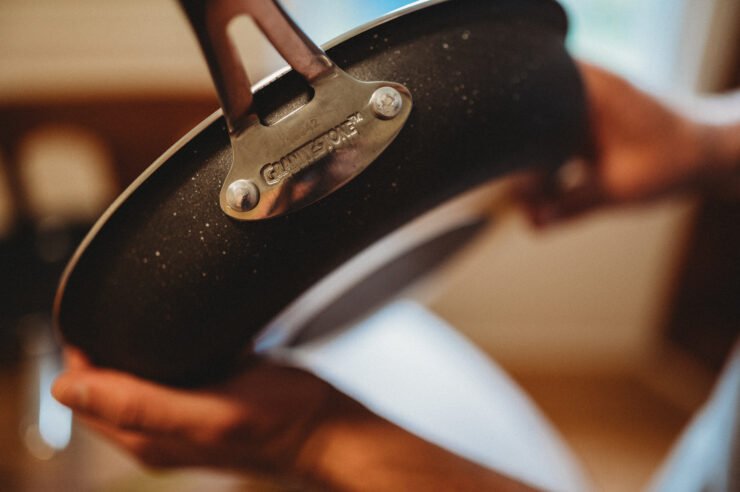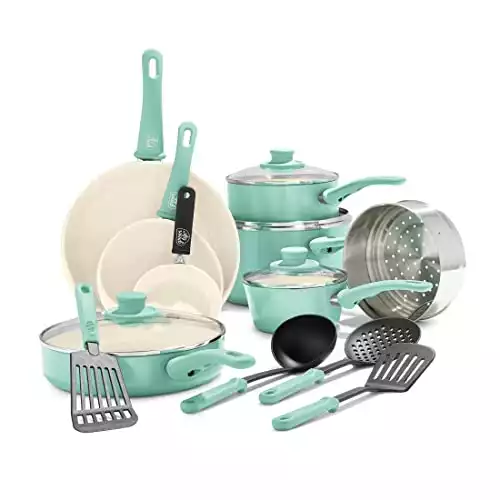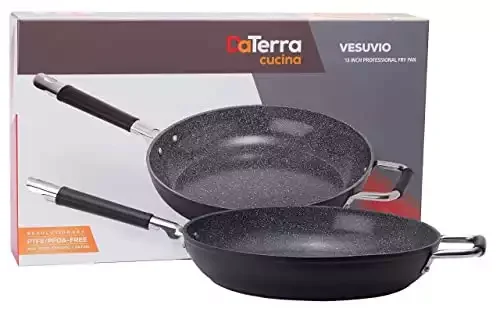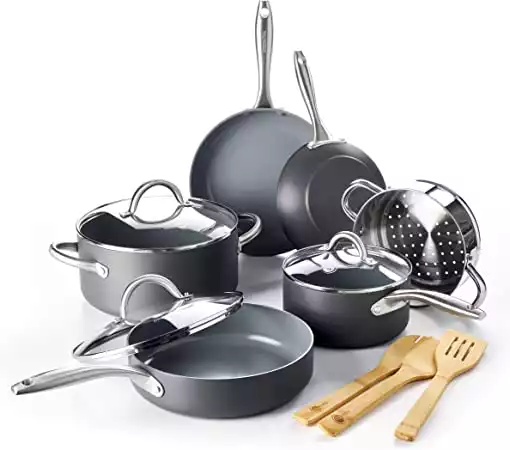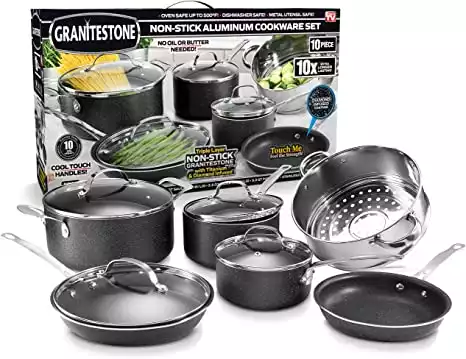Like many people, we first discovered Granitestone via their larger-than-life As Seen on TV infomercials. If you haven’t seen one of those spots, they’re certifiably outrageous.
The brand promises to free you from “your sticky pan nightmares,” if only you’ll buy into their collection of durable nonstick cookware.
When Granitestone started showing up at Walmart and a few local grocery stores, we decided it was time to bring their products into our Test Kitchen. We did this as part of our broader search to find the best nonstick cookware.
In this writeup, I’ll share my experience and cover the following:
- My thoughts on how Granitestone lived up to the brand’s promises,
- How the pan looks and feels (with lots of pictures)
- A few things I wish I knew before I bought it
- How to distinguish between the various sets they offer
Let’s get into it!
In This Article
What We Tested
Granite Stone is a lightweight aluminum pan with a non-stick coating that many people will recognize As Seen on TV. The pan is sold by E. Mishan & Sons, Inc (Emson). You probably haven’t heard of Emson, but the company is responsible for a slew of television-supported promotional products such as Gotham Steel and the Magic Bullet. Their portfolio is impressively full of gimmicky mass-appeal products, and true to form, they make several big claims about Granite Stone. Let’s examine,
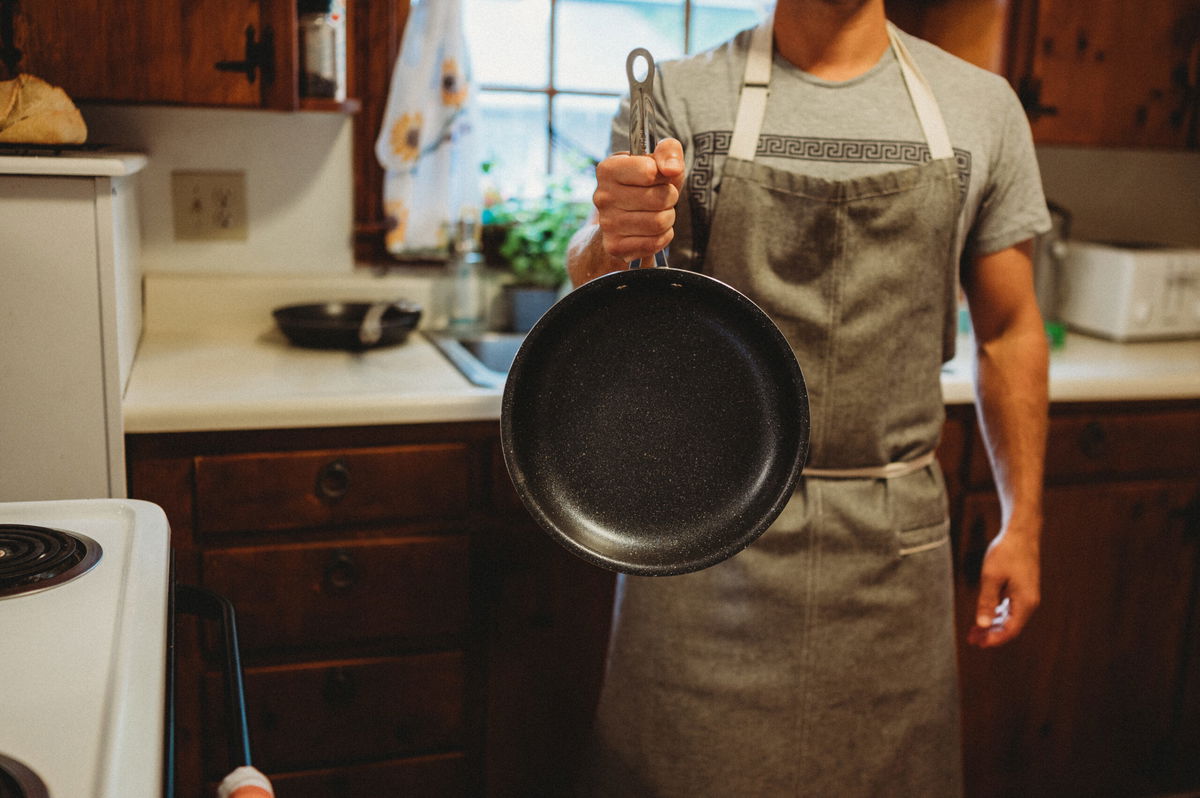
Granite Stone claims to be “designed to withstand anything,” thanks to a special granite coating which is applied to the exterior of a high-grade pressed aluminum base. This coating is said to prevent aging or heat warping.
The pan is advertised to be dishwasher safe, to make for an incredibly simple cleanup after each meal. It is also said to be oven safe to 500 F, which is hotter than most common baking applications.
Granite Stone claims that the pan heats evenly when you fry, bake, saute, or sear. A natural mineral coating applied to the pan exterior is said to support “an ideal non-stick cooking and cleaning experience.”
How It Worked
Before making a purchase we think you should dissect the brand’s claims, to separate meaningful features from infomercial gimmicks. We spent hours sorting through owner feedback, product info, and patent materials specifications to help you know before you buy.
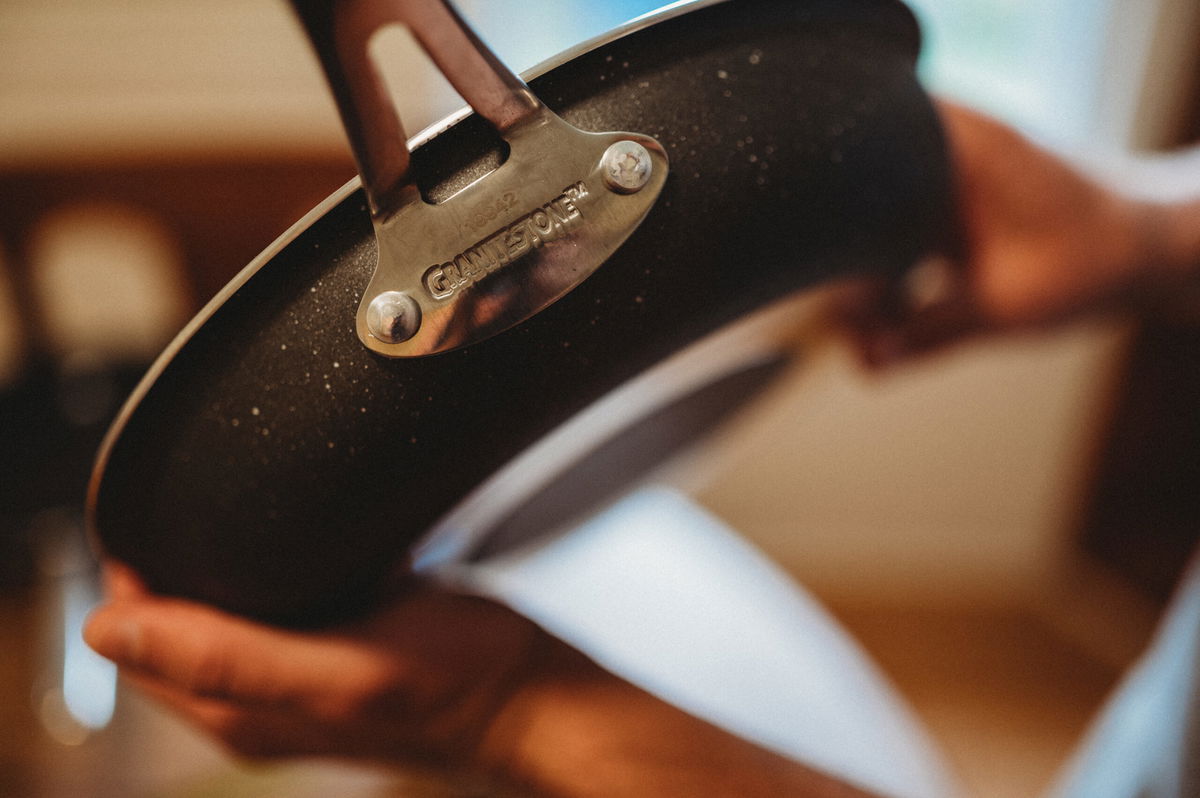
The Pan’s Base: Fast Heating Aluminum
What is Granite Stone cookware made out of? The pans are built atop a pressed aluminum base, with non-stick enamel coating baked atop.
Aluminum is awesome because it heats so quickly, and is very responsive to changes in temperature. This is the same quality that makes copper cookware popular in high-end and some professional kitchens. Fortunately, aluminum is significantly more affordable than copper.
One thing to note is that aluminum won’t retain heat as effectively as a cast iron skillet might, so if your stove has a difficult time maintaining a steady cooking temperature that might be a problem with this pan. Cast iron is a lot more difficult to work with because it heats up slowly, requires special maintenance, and if you overheat it then it takes forever to cool down. But it is great at maintaining a cooking temperature, and can be used at higher heats.
Nonstick Surface: Excellent PTFE Food Release
The Granite Rock pan and Granitestone cookware both use a PTFE-based coating to create food release on the cook surface. You may also be familiar with PTFE by the popular brand name, “Teflon.” It’s one of the slickest substances known to man and has been used in nonstick cooking for as long as there has been nonstick cookware.
Recently PTFE has been the subject of controversy related to the health and environmental impacts of a material used in its manufacturing process called PFOA. I’ll stick to the broad strokes here, though I have recently written more extensively on the topic (in this article) for anyone who wants to dive deeper.
In every Granitestone listing I’ve seen, the brand makes it a priority to promote that PFOA was not used in the creation of their product. Of course, nearly every global manufacturer stopped using PFOA by 2013, so that’s not surprising. Even so, a cottage industry of teflon-free ceramic cookware has been growing for kitchens that simply want to steer clear of this issue.
It is worth noting there are some tradeoffs with using a ceramic nonstick pan, compared with PTFE-based nonstick products. Ceramic tends to be less durable, and the nonstick property isn’t quite as good.
Experts regard PTFE as inert and harmless to humans, so long as it is used at low-to-medium temperatures. It does start to deteriorate around 500 F, which is the temperature rating for Granitestone cookware, so you should never cook on high-heat settings. If you are a bird owner, this is not a good pan for your kitchen. More on that here.
I’ve found that most PTFE-based pans are durable for 2-5 years before the nonstick property fades. Owner feedback on the Granite Rock pan holds true to this. You should also know that when a pan is treated poorly (used with metal utensils, run through the dishwasher, cooked at high temperatures, etc) the lifespan can be shorter.
In contrast, ceramic nonstick pans usually last under 2 years.
Stovetop Compatibility: Everything Except Induction
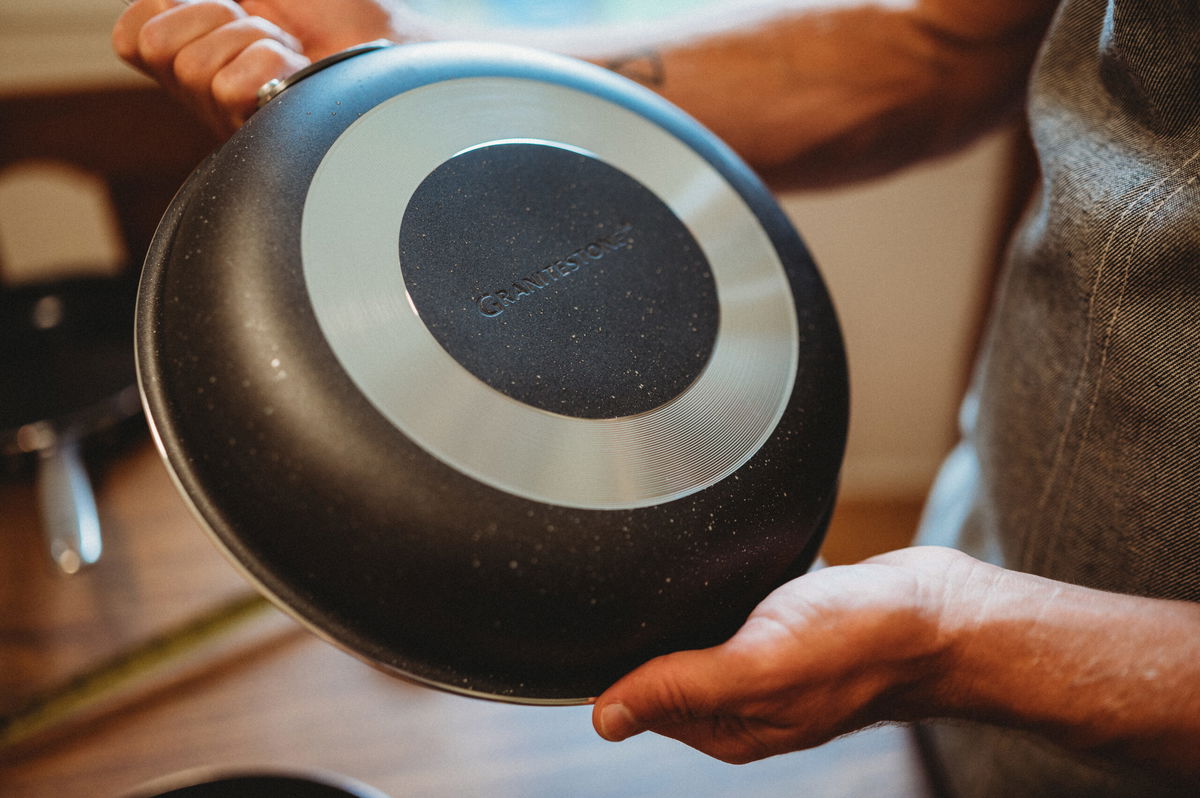
Because the aluminum base does not include stainless steel or magnetic iron, the Granite Rock pan simply won’t heat up if you try it on an induction burner. For most people this shouldn’t be a problem – since only about 10% of American kitchens use an induction range.
Granitestone cookware is also oven-safe and can handle temperatures up to 500 F. So if you want to sear and bake or braise a dish, that is a possibility. Although, if you’re doing oven dishes all the time I would recommend a cast iron dutch oven instead.
While you can do a lot with this set, it’s important to understand that Granitestone and other nonstick cookware were not made for high-heat cooking. When using this pan on a gas or electric range, keep your temperature dial set on low-to-medium for best results.
Handles and Lids: Glass and Stainless Steel

Granitestone cookware uses stainless steel for their “stay cool” handles, which gives them a sturdy feel and great aesthetic. The functional reason for this is that stainless steel heats up (much) more slowly than the aluminum base, which allows it to remain cool to the touch. The handle design and shape emphasize this quality.
While the handles will remain cool on most stovetops, you should keep an oven mitt nearby when using these pans in the oven. While they are “oven safe” the handles are not “stay cool” in the oven, and will get very hot. The handles may also get hot if exposed directly to the flame of a gas burner.
The Granite Rock pan’s glass lids are convenient for monitoring food while it cooks. This is a quality that I really like. Some kitchens prefer stainless steel lids because they are more durable and less likely to collect grime where the glass of the lid fastens to the stainless steel handle and rim. For me, I like to see what is happening in the pan so that I don’t allow ingredients to overcook or dry out.
Granitestone Diamond
Granitestone Diamond capitalizes on a popular trend to infuse lab-grown diamond dust into the nonstick coating of the pan. It seems like all of the TV-advertised cookware companies are doing it now, so I can understand why Granitestone didn’t want to miss the boat.
Do “diamonds” really make a difference though? In our experience, this addition of diamonds is interesting to talk about, but it doesn’t improve the durability or nonstick performance of the pan in a meaningful way.
Granitestone Blue
There are a few interesting and material differences to the Granitestone Blue line.
First off, the handle design has been updated. It’s bigger and rises away from the pan at an angle. I’d consider both of these decisions to be good ones. The short flat handle on the original line was one of my least favorite features.
The base material of the Blue line is stainless steel. Compared with the original pan, which is aluminum, stainless steel is less responsive to changes in temperature.
Practically speaking, this means these pans will heat up more slowly. And also that they will do a better job of maintaining a consistent temperature, even if your heating element fluctuates. The steel construction also makes them induction compatible.
Granitestone messages the merits of the strength of steel. Steel is more sturdy than aluminum, to be sure, but the metal was never the source of durability issues in these products. The nonstick coating will, once again, be the first thing to go.
Frying Pan vs Full Set
Granite Stone cookware is available in a variety of sizes, which you can find packaged as individual pieces or bundled with a full set. While the full set is very affordable, it’s definitely worth considering how you cook and how much storage space is available in your kitchen before picking up all 10 pieces.
If you want the simplest possible way to outfit a new kitchen for cheap, then one of the sets is probably a great pick. The 24-piece set, for example, includes everything you might want for a basic kitchen except a cutting board and mixing bowl. The cookware is easy to clean, and the knives will get you a few years down the road without any real maintenance required.
If you are looking for only the most essential pieces of Granitestone cookware, then stick to the frying pans. For all of its conveniences, nonstick cookware is the most effective with delicate dishes like eggs, fish and pancakes.
The 5.5″ egg pan doesn’t take up much storage space and is the perfect size for frying eggs. It’s effectively too small for anything else, including scrambles where you need to mix ingredients as they cook.
A 10″ fry pan is the perfect size for most kitchens, though you may consider going bigger if you have many mouths to feed.
Care Tips
Owners say the pan itself is light, but sturdy. Much like other pans in the ceramic nonstick category, it is rare that you will find a pan with a lifespan greater than 2 years. In that regard, Granite Stone is similar to the competition.
Whether you decide this or another nonstick pan is the right fit for your collection, learn the care instructions before using. Practical steps as simple as avoiding metal utensils can add months to the lifespan of your set.
Learn how to care for your pan now, or you’ll soon be buying a replacement.
Avoid the dishwasher.
While almost all nonstick pans are marketed as “dishwasher safe,” the care instructions recommend hand washing. It may not seem like much, but the constant banging together of dishes in an automated washer can easily scratch the nonstick coating. Even for top-end nonstick cookware, a trip through the dishwasher is often followed by a rapid decline in performance.
Let the pan cool before cleaning it.
It’s easy to love the sizzling sound of a hot pan entering cold water. Your non-stick pan does not love this as much as you do.
The aluminum base and non-stick coating of your pan are made of different materials. Each material layer expands and contracts at a different rate when its temperature changes. Dropping the pan into water changes the temperature quickly, and can pull the layers apart as the layers quickly contract. You can add life to your pan by waiting for it to cool before cleaning.
Use a paper or cloth towel to clean quickly.
In many cases, you don’t need soap and water to clean your pan after use. Simply wipe it down with a soft cloth or paper towel after the pan has cooled. Soap, and some city water, can put extra wear and tear on your pan. In many cases it is overkill.
Do not stack your pans.
The weight of pans on pans creates friction which can age your pan rapidly, or create immediate damage like scratches, dents, and chips. Similarly, metal utensils used on the nonstick surface can cause a pan to quickly wear out.
Avoid low-smoke oils and sprays.
Do not use aerosol spray oil or butter to lubricate this pan. These low-temperature cooking fats tend to build up residue on your cookware. This can be very difficult to clean, and will shorten the life of your pan.
Competitors: What is the best granite cookware?
There are several competitor brands to choose from, but we recommend side-stepping “granite” infomercial gimmicks and looking toward other types of ceramic non-stick pan.
Here are a few alternatives,
GreenLife
If you are looking for a bargain that performs, GreenLife makes a good medium heat pan at an affordable price. The pan comes in 7 colorways, each with a soft grip Bakelite handle. The white pan bottom adds contrast between pan and food that can come in handy, especially when cooking in a dim kitchen.
DaTerra Cucina
DaTerra Cucina makes one of the most durable nonstick frying pans we reviewed. Pricing is generally more expensive than Granitestone and most As Seen on TV cookware, but the performance and durability is far superior. We like the 13” Vesuvio frying pan by DaTerra Cucina for families with many mouths to feed.
Greenpan
The 10” Paris fry pan by Greenpan was recently our runner-up non-stick pan. It is well constructed and cooks evenly. The materials used are incredibly healthy to cook on, making it a great fit for home chefs who prioritize safe cooking.
My Recommendation
Granitestone can be a good “first pan” if you are just getting started in the kitchen. It also may work well to outfit a short-term rental, dorm room, or occasional getaway like an RV without breaking the bank.
The bottom line is that Granite Rock pan can be good fit if you are building a kitchen on a budget and durability isn’t your main priority.
The pans don’t live up to the performance and durability claims of the advertisements, but the price is hard to beat. It’s likely that, with regular use, you’ll need to replace your Granitestone pan in less than a year.
The aluminum construction offers great heat conduction, which means you won’t have to wait very long to start cooking once you get it on the stove. The heat retention is less than other affordable materials like a cast iron skillet and, while the manufacturer rates this pan as “oven safe” the temperature limitations mean that it’s not a practical dish to use for sear-and-bake recipes. But the natural mineral coating is incredibly easy to clean, which is what attracts most owners.
Granitestone is among the most affordable PTFE nonstick cookware options available, and good enough to help you learn the basics of cooking and understand if better equipment is something you want to put more money into in the future.
Granite Stone is an affordable way to get started if you're on a budget and trying to build your kitchen collection from scratch. While the product doesn't live up to its outlandish advertising hype, it can still be an affordable option to outfit a new kitchen.
What we like
- It’s incredibly affordable.
- Available in a variety of sizes.
- Nonstick works well out-of-the-box.
What We don’t
- Like most nonstick pans, its lifespan is limited.
- Not compatible with an induction cooktop.
- Doesn’t live up to the advertising hype.
FAQs
Granite Rock vs Granite Stone – What’s The Difference?
They Are The Same Pans From The Same Company. GRANITEROCK And GRANITESTONE Are Both Trademarks Of Emson. The Company Launched Their Product Line Of Non-Stick Pans Under The Graniterock Brand In 2018 Before Abandoning That Trademark And Replacing It With Granitestone A Year Later.
Is Granite Stone a safe cookware?
Granitestone cookware is manufactured using a PTFE nonstick surface. This material is considered chemically inactive when used with food. It can, however, emit fumes when heated over 500 degrees Fahrenheit.
Is Granite Stone good for cooking?
Granitestone cookware is affordable, easy to use and clean. But it does have some limitations. The aluminum pan base heats quickly and evenly, but doesn’t retain heat very well. There are temperature limitations, so it’s not great for delivering a hard sear. And it’s not compatible with induction stovetops. With that said, the nonstick surface works great and is more durable than many budget-minded nonstick options.
Is granite stone better than teflon?
Granitestone is made using a PTFE nonstick cook surface, which is often referred to by the popular brand name “Teflon.” Although their coating may be produced by another manufacturer, the underlying chemistry is exceptionally similar (if not the same).
